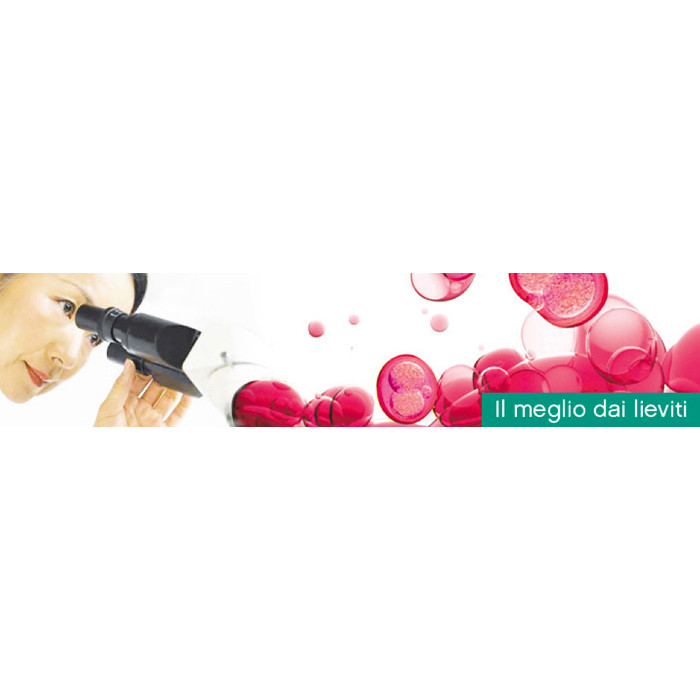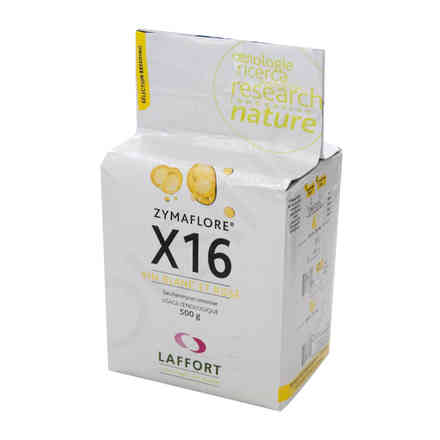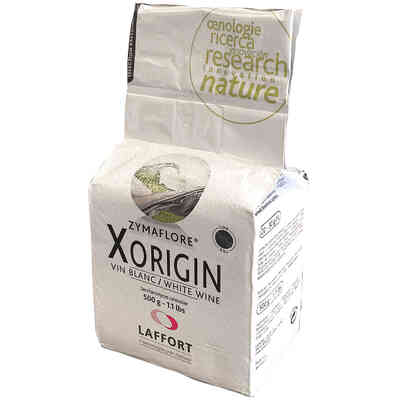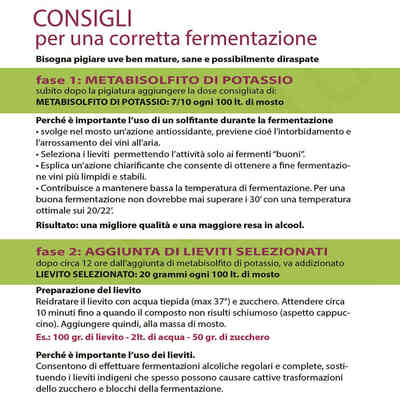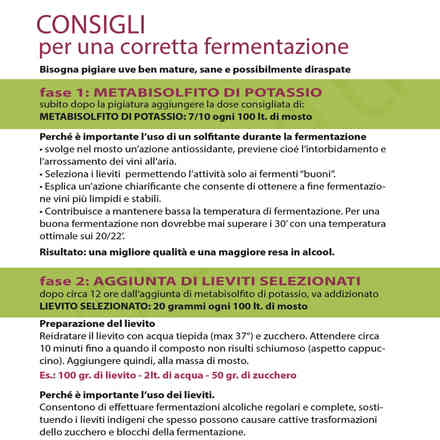Yeast for red wines Zymaflore FX10 (500 g)
Description
Yeast for great red wines for long ageing, powerful and elegant, with an important polyphenolic structure and non-aggressive tannins. It ensures a correct fermentation process, good resistance to alcohol (15.5% vol).
Final objective:
Long-ageing wine; Respect of the polyphenolic potential Structured and elegant wines with velvety tannins respecting the typicality.
Recommended for grape varieties:
Barolo, Brunello di Montalcino, Nobile di Montepulciano, Aglianico, Nero d'Avola.
Fermentation characteristics:
- Alcohol tolerance: up to 16% vol.
- Wide temperature tolerance: 20 - 35°C.
- Low nitrogen requirements.
- Low production of volatile acidity and H₂S.
- Good compatibility with malolactic bacteria.
- Strong fructosophilia.
Organoleptic profile:
- Important release of polysaccharides (volume).
- Preserves polyphenolic potential (structure and colour).
- Combination of the parietal polysaccharides with the wine's tannins, ensuring smoothness even with high polyphenol concentrations.
- Excellent suitability for "élevage sur lies".
- Respect for "terroir" characteristics (very low production of fermentation aromas).
Average dose of use:
15-30 g/hL
Dry wine-making yeast, suitable for use in foodstuffs.
Complies with the International Oenological Codex. Does not contain GMOs
Preparation:
Rehydrate according to the protocol indicated on the packaging.
- Use a clean container of inert material.
- Do not mix with other products (except Superstart)
- Use the product immediately after preparation
- Do not use if the package is not intact
Analysis Type:
- Moisture (%): < 8
- Live cells LSAS (CFU/g): ≥ 2,1010
- Lactic bacteria (CFU/g): < 105
- Acetic bacteria (CFU/g): < 104
- Yeasts of genus other than Saccharomyces (CFU/g): < 105
- Yeasts of different species or strain (%): < 5
- Coliforms (CFU/g): < 102
- Moulds (CFU/g): < 103
- E. Coli (/g): abs.
- Salmonella (/25 g): abs.
- Staphylococcus (/g): abs.
- Lead (ppm): < 2
- Arsenic (ppm): < 3
- Mercury (ppm): < 1
- Cadmium (ppm): < 1
Packaging:
500g bag.
Store in a dry place, at a moderate temperature (4 to 8°C) and in the original packaging. The best use-by date is 18 months.
The ZYMAFLORE F15®, VL3®, and more recently X5®, X16®, FX10® and RX60® yeasts are worldwide references.
Nowadays, winemakers expect much more from yeast than the simple and complete transformation of sugars; our team of researchers responsible for isolating and selecting new yeast strains is very clear about this. It is thanks to this investment in research and development that LAFFORT is able to offer, through its ZYMAFLORE® range, oenological yeasts adapted to revealing the intrinsic potential of the grape while offering excellent fermentation performance.
- The first strategy consists in isolating the yeasts in nature (Ecolselection): in the vineyard, in the cellar, in spontaneous fermentations, etc. These so-called "terroir" yeasts have proved to be particularly suited to revealing the potential of a particular type of wine or vine. This is the case, for example, with F15®, F83®, VL1® or VL3®.
- Another selection strategy is based on breeding. This technique, which exploits a naturally occurring phenomenon, provides the possibility of combining the characteristics of different yeasts in a single strain without resorting to genetic manipulation techniques. It is possible to cross two individuals (yeasts) with different genetic heritage and isolate in the progeny the individuals with the desired characteristics. For example, by crossing a yeast with very high fermentation performance with another yeast with very interesting detection or aromatic expression capacities, X5®, X16® and RX60® strains were obtained. With the same technique, applying the strategy of backcrossing, it was possible to improve the historic and glorious F10® strain, obtaining FX10®, which maintains 94% of the genetic heritage of F10® and retains its highly appreciated oenological potential for the production of great wines, while combining it with great fermentation vigour. This technique offers very interesting prospects for responding promptly to the evolution of market demands.















